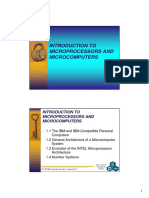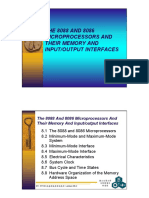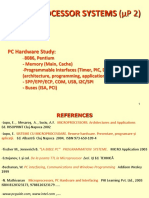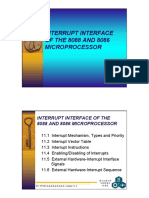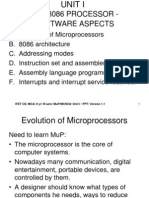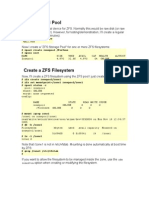DEVELOPMENT OF THE INTEL X86
FAMILY MICROPROCESSOR
DEVELOPMENT OF THE
INTEL X86 FAMILY
MICROPROCESSOR
13.1
13.2
13.3
13.4
13.5
13.6
Introduction
Programming Model
Addressing Modes
Instruction Set
The X86 Hardware
PC Motherboard Architecture
611 37100 Lecture 13-2
13.1 Introduction
13.1 Introduction
The 8088 and 8086 evolved into faster versions,
The 486 is basically a large integrated circuit which
versions with greater memory addressing space,
versions which process 32-bit data words.
IBM introduced the PC/AT using the 80286 in 1984.
One of the features introduced with the 80286 was
real and protected modes of operation, and yet
another feature added hardware multitasking.
The 80386 has a 32-bit data bus and a 32-bit
address bus, and it uses 32-bit internal registers.
The 386 microprocessors offered advance virtual
memory, advanced protected mode, and higher
speeds.
contains a fast 386 processor, a math coprocessor, a
memory management unit (MMU), and an 8-Kbyte
cache memory.
The 486 achieves its high-speed operation from
faster clock speeds, an internal pipelined architecture,
and the use of reduced instruction set computing
(RISC) to speed up the internal microcode.
Intel elected to name the 586 device Pentium. The
Pentium uses superscalar architecture incorporating
a dual-pipelined processor which lets the Pentium
process more than one instruction per clock cycle.
611 37100 Lecture 13-3
611 37100 Lecture 13-4
13.1 Introduction
13.1 Introduction
The Pentium are implemented with 8-Kbyte data and
Major attributes of the X86 processors
8-Kbyte code caches on chip that is also a feature
designed to improve processing speed.
The Pentium has a 64-bit data bus. This means that it
can perform data transfers with an external device
twice as fast as a processor with a 32-bit data bus.
A new advanced computing technique used in the
Pentium is called branch prediction. Using branch
prediction, the Pentium makes an educated guess
where the next instruction following a conditional
instruction will be.
611 37100 Lecture 13-5
Attribute
8088
8086
80286
611 37100 Lecture 13-6
386SX
386DX 486SX 486DX Pentium
�13.2 Programming Model
13.2 Programming Model
The 8088 and 8086 define the base programming
model for the entire X86 family of microprocessors.
The 386, 486, and Pentium uses 32-bit registers. The
8 general-purpose registers are called the EAX, EBX,
ECX, EDX, ESI, EDI, ESP, EBP registers. Each
register can be addressed in 1-, 8-, 16-, or 32-bit
modes.
The first five bits of the X86 flag register are identical
to the flag bits in the 8085 8-bit microprocessor.
To give the X86 processors even greater speed, the
processors include various levels of instruction
prefetching and data caching.
611 37100 Lecture 13-7
13.2 Programming Model
base register set
611 37100 Lecture 13-8
13.3 Addressing Modes
The X86 flag (status) register
8086
611 37100 Lecture 13-9
The X86 programming model as described by the
8085
The X86 processors can address immediate data, I/O
ports, registers, and memory locations using different
addressing modes.
The 8088/8086 addresses 1 Mbyte (220). The 286
addresses 16 Mbytes (224), and members after the
386 can address 4 Gbytes (232).
The X86 processors have a separate ALU to perform
calculation of memory address, so the main ALU is
free to perform data calculation.
Each of the newer X86 processors has two
fundamental modes of operation. They are called the
real mode and protected mode.
611 37100 Lecture 13-10
13.3 Addressing Modes
13.3 Addressing Modes
In the real mode, all processors are limited to
In the protected mode, the address in the segment
addressing 1 Mbyte of memory. In this mode they
work just like the 8086. In the protected mode, they
are able to address many more memory locations.
To put an X86 processor in the protected mode, the
protection enable bit (bit 0) in the machine status
register must be set to logic 1.
Once the protection enable bit is set, it can be
cleared only by resetting the processor. This makes
entering the protected mode a one-way street.
In the protected mode, the X86s MMU is used to
allow the processor to address physical memory
greater than 1 Mbyte and to allow the programmer to
use virtual memory.
611 37100 Lecture 13-11
register points to a memory location called a
segment descriptor table. Data in this table is used
in place of the segment base address data to build
the memory address.
The segment descriptor table gives the X86
programmer one more way to keep different
addressing for different kinds of use and therefore to
protect the data.
611 37100 Lecture 13-12
�13.3 Addressing Modes
13.3 Addressing Modes
The upper 13 bits of the segment register data are
Each segment descriptor table contains 8 bytes. The
used to select a particular segment descriptor. The
first three bits request a priority level (RPL0, RPL1)
and select either a global descriptor table or a local
descriptor table.
3
8 bytes provide a 24-bit (286) or 32-bit (386 and
higher) segment base address plus additional
information.
13-bit segment description address
RPL0
RPL1
GDT or LDT
The structure of the segment descriptor table
611 37100 Lecture 13-13
611 37100 Lecture 13-14
13.3 Addressing Modes
13.3 Addressing Modes
Addressing memory using the segment descriptor
There is one segment descriptor register for each
tables
segment register.
If the memory does not really exist, then a
subprogram is used to load the needed information
from mass storage into the appropriate section of
physical memory.
Segments for the 286 are limited to 64 Kbytes.
Segments for the 386 and newer processors can be
either up to 1 Mbyte or up to 4 Gbytes long.
The X86 processors offer four levels of privilege for
any form of memory access. This is used to help the
programmer when writing operation system software
and software for a multi-user or multitasking
environment.
611 37100 Lecture 13-15
611 37100 Lecture 13-16
13.3 Addressing Modes
13.3 Addressing Modes
The X86 privilege levels. PL0 is the highest privilege;
Different privilege layers for a multi-user or
PL3 is the lowest privilege.
multitasking operating system.
PL3
Applications
PL2
Operating
systems
PL1
System
PL0
Kernel
most
privilege
Services
Extensions
Software
611 37100 Lecture 13-17
611 37100 Lecture 13-18
�13.4 Instruction Set
13.4 Instruction Set
The X86 processors are upwardly compatible; that
Evolution of the X86 family instruction set
Protected mode
is, software written for an earlier version will always
run on a later version. The newer processors have a
special mode (the real mode) which allows them to
operate as though they were an 8086.
There are eight major types of X86 instructions:
Real mode
Base
Instruction
set
13.4 Instruction Set
611 37100 Lecture 13-21
80386
80286
8086
611 37100 Lecture 13-20
386
486
The X86 data transfer instructions
Instruction
Subtype
Mnemonic Description
8088/
8086
286
386
486
13.4 Instruction Set
The X86 data transfer instructions some
The X86 arithmetic instructions
new instructions
Mnemonic Description
POPA, PUSHA Exchange all register data with
the stack.
BSWP Byte swap, reorder the 4 bytes in a 32bit word.
LAR Load the access rights from a segment
descriptor table into a general-purpose register.
LGDT, LIDT, LLDT, SGDT, SIGT, SLGT
Transfer the contents of a segment descriptor
table (Global, Interrupt, Local).
LMSW Load machine status word.
Instruction
Subtype
611 37100 Lecture 13-22
13.4 Instruction Set
611 37100 Lecture 13-23
80486
13.4 Instruction Set
The X86 data transfer instructions
286
Base
Base ++
extended
Extended
+ 80386
Specific
Instruction
Instruction
set
set
System control
Instruction set
Base
Base ++
extended
extended
Instruction
Instruction
set
set
611 37100 Lecture 13-19
8088/
8086
System control
Instruction set
Real mode
System control
Instruction set
+
BaseBase
+ Extended
extended
+ 80386
+ 80486
Specific
Instruction
Instruction
set
set
Protected mode
Protected mode
Data transfer
Arithmetic
Logical and shift-rotate
String manipulation
Bit manipulation
Control transfer
High-level language support
Processor control
Mnemonic Description
Real mode
8088/
8086
611 37100 Lecture 13-24
286
386
486
Instruction
Subtype
�13.4 Instruction Set
13.4 Instruction Set
The X86 arithmetic instructions
The X86 logical instructions
Mnemonic
Description
8088/
8086
286
386
486
Instruction
Subtype
Mnemonic
611 37100 Lecture 13-25
Description
8088/
8086
286
386
611 37100 Lecture 13-26
13.4 Instruction Set
13.4 Instruction Set
The X86 shift and rotate instructions
The X86 string manipulation instructions
Mnemonic
Mnemonic
Description
8088/
8086
286
386
8088/
8086
286
13.4 Instruction Set
The X86 bit manipulation instructions
The X86 control transfer instructions
Mnemonic
Description
611 37100 Lecture 13-29
8088/
8086
286
386
486
611 37100 Lecture 13-28
13.4 Instruction Set
Mnemonic
386
486
611 37100 Lecture 13-27
Description
486
Description
8088/
8086
286
386
486
Instruction
Subtype
486
611 37100 Lecture 13-30
�13.4 Instruction Set
13.4 Instruction Set
The X86 control transfer instructions Five
The X86 control transfer instructions Five
unconditional jumps
unconditional jumps
611 37100 Lecture 13-31
611 37100 Lecture 13-32
13.4 Instruction Set
13.4 Instruction Set
The X86 control transfer instructions Four iteration
The X86 control transfer instructions Interrupt vector
control instructions
Interrupt Vector
Number
Interrupt Type
611 37100 Lecture 13-33
Instruction or Condition Which
Can Cause Interrupt
First Processor
to Use This
Interrupt
611 37100 Lecture 13-34
13.4 Instruction Set
13.4 Instruction Set
The X86 high-level language support instructions
The X86 processor control instructions
Mnemonic
Mnemonic
Description
611 37100 Lecture 13-35
8088/
8086
286
386
Description
8088/
8086
286
386
486
Instruction
Subtype
486
611 37100 Lecture 13-36
�13.5 The X86 Hardware
13.5 The X86 Hardware
The maximum and minimum mode of the 8088/8086
Typical packages of newer X86 processors
was dropped from the 286 and from later versions of
the X86 processor family.
The 286 and newer processors do not use a
multiplexed address-data bus.
The newer microprocessors in the X86 family are
usually packaged as:
Pin grid array (PGA)
Quad flat pack (QFP)
Plastic leadless chip carrier (PLCC)
A 114-pin pin grid array package
A 132-pin quad flat pack
A 132-pin plastic leadless chip carrier
611 37100 Lecture 13-37
611 37100 Lecture 13-38
13.5 The X86 Hardware
13.5 The X86 Hardware
Typical packages of newer X86 processors
Typical packages of newer X86 processors
Attribute
PGA
QFP
8088
8086
286
386SX
386DX
486DX
Pentium
The X86 processor packages and pin count
PLCC
611 37100 Lecture 13-39
13.5 The X86 Hardware
13.5 The X86 Hardware
The X86 processor pin assignment
Processor Signal
Function
Input or
Output
8086 (Max
Mode)
611 37100 Lecture 13-41
286
611 37100 Lecture 13-40
386
The X86 processor pin assignment
486
Processor Signal
Function
Input or
Output
8086 (Max
Mode)
611 37100 Lecture 13-42
286
386
486
�13.5 The X86 Hardware
13.5 The X86 Hardware
The 80486SX processor pin layout
The 80486SX processor pin numbering
611 37100 Lecture 13-43
611 37100 Lecture 13-44
13.5 The X86 Hardware
13.5 The X86 Hardware
The 80486SX processor block diagram
Block diagram of a maximum mode 8086 system
611 37100 Lecture 13-45
611 37100 Lecture 13-46
13.5 The X86 Hardware
13.5 The X86 Hardware
Implementing the 486DX-based PC with VLSI parts
80286 processor summary
2nd generation processor
Introduced in 1981
CPU behind IBM AT
Throughput of original IBM AT (6MHz) was about 500% of
IBM PC (4.77MHz)
Level of integration: 134k transistors (29k in 8086)
16-bit processor, available in higher clock frequencies: 25MHz
Fully backwards compatible to 8086
Improved instruction set and execution
Real mode and protected mode
16MB addressable physical memory
On-chip MMU (1GB virtual memory)
Non-multiplexed address-bus and data-bus
611 37100 Lecture 13-47
611 37100 Lecture 13-48
�13.5 The X86 Hardware
13.5 The X86 Hardware
80386 processor summary
80486 processor summary
3rd generation processor
Introduced in 10/1985
Full 32-bit processor
275k transistors. CMOS. 132-pin PGA package
Clock speeds: 16-33MHz
Protected Mode for Multitasking support
Real mode (native 8086 mode)
Processor powers up in real mode
System management mode
Power management or system security
Processor switches to separate address space, while
saving the entire context of the currently running
program or task
611 37100 Lecture 13-49
Introduced in 1989
High integration
On-chip 8K Code and Data cache
Floating Point Unit
Paged, Virtual Memory Management
Multiprocessor support
Multiprocessor Instructions
Cache Consistency Protocols
Longer prefetch queue (32-bytes as opposed to
16 on the 80386)
Higher frequency operation: up to 120MHz
>1.2M transistors, 0.8m CMOS. 168-pin PGA.
611 37100 Lecture 13-50
13.5 The X86 Hardware
13.6 PC Motherboard Architecture
Pentium processor summary
Top level PC system architecture
32-bit Microprocessor
32-bit addressing
64-bit data bus
Superscalar architecture
Two pipelined integer units
Capable of under one clock per instruction
Pipelined floating point unit
Separate code and data caches
8K code, 8K write back data
2-way 32-byte line size
MESI cache consistency protocol
Advance design features
Branch prediction
237-pin PGA
611 37100 Lecture 13-51
611 37100 Lecture 13-52
13.6 PC Motherboard Architecture
13.6 PC Motherboard Architecture
Top level PC system architecture
The integration of chipset has reduced a chipset
to just 2 main components--the North Bridge (NB)
and the South Bridge (SB).
In the case of the North Bridge, the chip connects
the front side bus [FSB] of the CPU to the DRAM
bus, the AGP graphics bus, and the South Bridge.
The South Bridge is intended as the place to
integrate all the (slower) peripherals like IDE, ISA,
USB, etc.
The North Bridge is also called the Memory
Controller Hub, and the South Bridge has become
the I/O Controller Hub.
The North Bridge
Four interface buses
611 37100 Lecture 13-53
CPU interface
The South Bridge interface
The DRAM system memory interface
The Accelerated Graphics Port interface
The function of the chip is to serve as a traffic cop
for data moving between the four buses.
With enough buffering and some complex
arbitration circuitry, a good North Bridge can
provide enough concurrency to insure that the
DRAM is used efficiently.
611 37100 Lecture 13-54
�13.6 PC Motherboard Architecture
13.6 PC Motherboard Architecture
The North Bridge
North Bridge is interfaced to the South Bridge with
PCI interface.
New interfaces include INTELs SB interface
which is an 8-bit port, running at 66 MHz and
transferring 4 bytes per clock, and AMDs
HyperTransport Technology that provides 2
channels for full-duplex operation.
VIA has defined their own South Bridge interface
that they call "V-Link". Very similar to Intel's
approach, this interface provides 266 MBs/sec of
bandwidth.
The North Bridge
Right now, the Pentium 4 chipsets only support
RDRAM, though Intel is working on a SDRAM
version (code-named "Brookdale").
For now, most chipsets support PC133 SDRAM's
and provide 1.064 GB/sec of memory bandwidth
from the 64-bit, 133MHz memory interface.
Support for DDR DRAM doubles this to 2.1
GB/sec.
INTEL developed the AGP interface as a way to
help control the system partitioning for graphics.
AGP would allow a graphics controller to use
system memory for storing graphics texture
information.
611 37100 Lecture 13-55
611 37100 Lecture 13-56
13.6 PC Motherboard Architecture
13.6 PC Motherboard Architecture
The North Bridge
Originally designed as a 66 MHz interconnect,
architecturally similar to a dedicated PCI bus,
AGP performance soon scaled to allow 2
samples/clock (AGP 2X) and then 4
samples/clock (AGP 4X). With a 32-bit (4 byte)
data path running at 66MHz and capable of 4
transfers per clock, the 4X interface yields 1.056
GBs/sec).
Some low-cost motherboard implementations
remove the graphics memory entirely and run with
a "Unified Memory Architecture (UMA)".
The South Bridge
While the North Bridge handles high-speed
memory arbitration, the South Bridge connects
with all the disparate peripherals.
Many new motherboards have dropped the ISA
bus entirely, but a lot of South Bridge chips still
provide the bus as an option for the motherboard
designer.
The PCI devices are integrated into the South
Bridge of many chipsets, including the IDE
controller, USB controller, SMBus controller, etc.
Most chipsets create an internal PCI-to-PCI
bridge, so that these devices don't take up
resources from the main PCI bus.
611 37100 Lecture 13-57
611 37100 Lecture 13-58
13.6 PC Motherboard Architecture
13.6 PC Motherboard Architecture
The South Bridge
INTEL invented the Low Pin Count Interface
(LPC) for the South Bridge that is a simple 4-bit
interface and is mainly used for connecting to the
Super I/O chip.
The Super I/O is where the really old legacy
devices live, including the serial ports, parallel
port, game port, PS/2 mouse/keyboard, infrared
interface, and floppy disk controller.
The South Bridge
The BIOS is low-level software that controls
devices on the motherboard. The processor
executes the BIOS code when the PC is first
booted, allowing memory testing and
configuration of peripherals.
INTEL calls their BIOS chip the Firmware Hub
(FWH), but it is basically the BIOS running in
FLASH (reprogrammable) memory. On an INTEL
chipset, the FWH shares pins with the LPC
interface.
611 37100 Lecture 13-59
611 37100 Lecture 13-60
10
�13.6 PC Motherboard Architecture
13.6 PC Motherboard Architecture
The South Bridge
The South Bridge chip usually have one or two
USB controllers, each able to manage 2
motherboard connectors.
USB is designed to daisy-chain through external
hubs to minimize the number of wires that must
be connected to the PC.
The term Integrated Drive Electronics (IDE)
means that most of the control for disk drive has
been integrated onto the drive's circuitry, instead
of being part of the motherboard or add-in card.
The South Bridge
The Audio Codec (AC) Link chipset is designed to
allow a digital connection to simple off-chip mixed
signal (analog/digital) electronics for audio and
telephony (modem/networking).
The current version is AC'97 2.2, and it provides a
5-signal interface to an external codec
(compression/decompression). In the case of
audio, the AC Link would connect to a chip that
includes a codec and digital-to-analog (D/A)
converters for driving audio speakers and analogto-digital (A/D) converters for sampling a
microphone or other audio analog inputs.
611 37100 Lecture 13-61
611 37100 Lecture 13-62
13.6 PC Motherboard Architecture
13.6 PC Motherboard Architecture
The South Bridge
Integrated internet controller
Other motherboard features
VRM (Voltage Regulator Module)
The VRM is a programmable voltage regulator, taking a
set of 5 VID (voltage identification) signals that are
coded to generate a precise voltage.
Clocks
Connectors
Jumpers
Most new motherboards now offer a "jumper-less" mode
where all functions are controlled through the BIOS.
Riser cards
Low-cost cards that provide external connectors to audio
devices, modems or networking.
611 37100 Lecture 13-63
611 37100 Lecture 13-64
13.6 PC Motherboard Architecture
13.6 PC Motherboard Architecture
Motherboard case study:
Motherboard case study:
Intel D815EEA
Intel D815EEA
611 37100 Lecture 13-65
611 37100 Lecture 13-66
11
�13.6 PC Motherboard Architecture
Motherboard case study:
13.6 PC Motherboard Architecture
Motherboard case study:
611 37100 Lecture 13-68
13.6 PC Motherboard Architecture
Support for AMD Socket A Processor, 266 MHz
FSB and a Big Heatsink
Special ASUS Chip for Hardware Monitoring
AMD 760 North Bridge with a VIA VT82C686B
South Bridge
BIOS Allows 1 MHz Frequency Increments
Audio Modem Riser (AMR) Allows Low-Cost
Audio or Modem
13.6 PC Motherboard Architecture
Motherboard case study: (2007)
611 37100 Lecture 13-70
13.6 PC Motherboard Architecture
Motherboard case study: ASUS M2N32-SLI Deluxe
ASUS M2N32-SLI Deluxe
611 37100 Lecture 13-71
Processor Socket
82815E Graphics and Memory Controller Hub (GMCH)
82801BA I/O Controller Hub (ICH2)
82802AB Firmware Hub (FWH)
SMSC LPC47M102 I/O Controller
PCI and CNR Slots
Memory Sockets
AGP Connector
Optional Audio Chips
Digital Video Out (DVO) Connector
IDE and Floppy Connectors
Onboard Speaker and Battery
Front Panel Connectors
Rear Panel Connectors
Jumpers
Power Supply
Motherboard case study: ASUS A7M266
ASUS A7M266
611 37100 Lecture 13-69
Motherboard case study: Intel D815EEA
Intel D815EEA
611 37100 Lecture 13-67
13.6 PC Motherboard Architecture
Based on the NVIDIA nFOrce 590 MCP
Northbridge chipset.
With support for 32 and 64-bit computing.
Supports dual PCI Express x16 slots running at
full speed to liberate graphics cards from the
narrow bandwidth platform of x8 speed only
4 DIMM sockets using Dual Channel 240-pin
DDR2 with a total capacity of up to 4GB
Built in IDE facilities that support Ultra DMA
33/66/100/133
611 37100 Lecture 13-72
12
�13.6 PC Motherboard Architecture
Features of modern motherboards
System on a chip (SOC)
A sealed-box PC with Device Bay to allow
peripheral connections.
Quad-Rate DRAM
USB 2.0
PCI-X for 1 GB/sec of bandwidth
Multiple processors
Reference: http://www.extremetech.com/
PC Motherboard Technology by J. Scott Gardner
611 37100 Lecture 13-73
13




